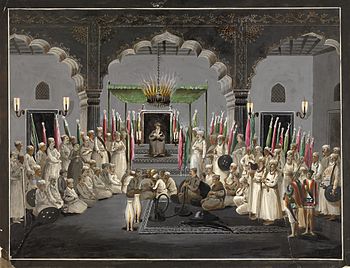Subahdar
Subahdar (Urdu: صُوبہ دار) (also known as Nazim or in English as a "Subah"[1]) was one of the designations of a governor of a Subah (province) during the Mughal era of India who was alternately designated as Sahib-i-Subah or Nazim. The word, Subahdar is of Persian origin.[2]
The Subahdar was the head of the Mughal provincial administration. He was assisted by the provincial Diwan, Bakshi, Faujdar, Kotwal, Qazi, Sadr, Waqa-i-Navis, Qanungo and Patwari.[3] The Subahdars were normally appointed from the Mughal princes or the officers holding the highest mansabs (ranks).
Nazim
A nazim (pronounced [ˈnaːzɪm], Urdu: ناظِم; from the Arabic word for "organizer" or "convenor", similar to a mayor, is the coordinator of cities and towns in Pakistan. Nazim is the title in Urdu of the chief elected official of a local government in Pakistan, such as a district, tehsil, union council, or village council.[4] Likewise, a deputy mayor is known as a Naib nazim (نائب ناظِم). The word naib in Urdu literally means "assistant" or "deputy" hence Naib nazim is similar in function to a deputy mayor.[5] He is also custodian of the house.[6]
The name which is used for the president of Islami Jamiat-e-Talaba, the Islamic Union of Students in Pakistan, is Nazim-e-ala. The nazim-e-ala is elected for one year, and after completing that tenure, all the members of IJT who are called (Arkaan) elect a new one. The "chief nazim," or district nazim, is elected by the nazims of Union Councils, Union Councillors, and Tehsil Nazims, who themselves are elected directly by the votes of the local public.
Pakistan originally had a system inherited from the time of British rule, in which a mayor was the head of a district. Under the Local Government Act, however, the role of the nazim became distinct from that of a mayor, with more power. The nazim system was introduced after the commissionerate system, imposed during British rule, was lifted by the government of Pakistan. Now there is no commissioner for any of the divisions, deputy commissioner for the districts, or assistant commissioners, since the Local Government act was imposed in the country in 2001. One exception, however, is Islamabad, the federal capital, where the commissionerate system remains in effect. In 2009, the new government restored the commissionerate system in the divisions but the nazims also remain in power.
A Nazim is also empowered to decide criminal cases.[7] The Nazim is the lowliest of elected officials in Pakistan.[8]
References
- George Clifford Whitworth. Subah. An Anglo-Indian Dictionary: A Glossary of Indian Terms Used in English, and of Such English Or Other Non-Indian Terms as Have Obtained Special Meanings in India. London: Kegan Paul, Trench & Co. 1885. p. 301.
- Islam, Sirajul (2012). "Subahdar". In Islam, Sirajul; Jamal, Ahmed A. (eds.). Banglapedia: National Encyclopedia of Bangladesh (Second ed.). Asiatic Society of Bangladesh.
- Mahajan V.D. (1991, reprint 2007). History of Medieval India, Part II, New Delhi: S. Chand, ISBN 81-219-0364-5, p.236
- Wajahat Ijaz (October 22, 2002). "Their way to parliament passed through Nazim's office". Pakistan Dawn.
- Zila Nazims & Naib Zila Nazims in the Province of NWFP - NRB Local Government Elections Archived 2009-05-06 at the Wayback Machine
- Overview of Town Municipal Administration - City Government of Lahore
- "A Nazim also decides criminal cases". Retrieved 11 August 2012.
- "Pakistan is "mainstreaming" misogynist tribal justice". The Economist. 13 October 2017.
